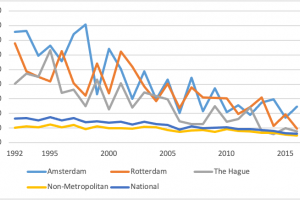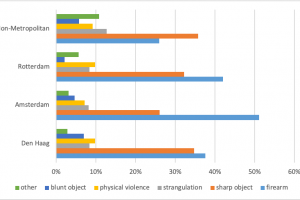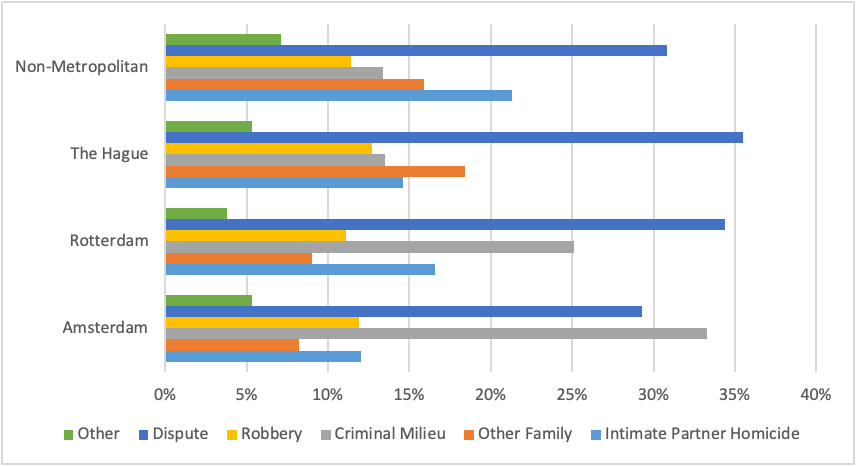Urban Homicide in the Netherlands
Data from the Dutch Homicide Monitor shows that the scope and nature of homicide differs between the metropolitan areas of Amsterdam, Rotterdam and the Hague, and the rest of the country.
Spatial distribution of crime
Since the 19th century, researchers have shown a keen interest in the spatial distribution of crime. They believed that progressing urbanization would lead to changes in the structures of society that would enable a favorable context for crime. They equated an ‘urban lifestyle’ with a lack of family structures, limited social control amongst neighbors and growing economic deprivations that together would form a breeding ground for crime, including violence. Indeed, research conducted in various regions in the world provide empirical proof of this hypothesis. For example, youths in metropolitan areas in the US are 5.6 times as likely to be killed in a homicide than youths living in rural areas. Homicide rates in Sao Paolo city were almost three times as high as the national Brazilian rate.


Urban homicide in the Netherlands
Using data from the Dutch Homicide Monitor, which encompasses all homicides in the Netherlands from 1992 until 2016, we see (Figure 1) that the homicide rate in the three largest cities of the Netherlands is indeed significantly higher than the national – and non-metropolitan homicide rate. In 2001, for example, Amsterdam’s homicide rate was five times as high as the national rate. Moreover, the rate of homicide in non-metropolitan areas has remained relatively stable over the years, with only a decline from 1,0 to 0,5 homicides per 100.000 population in the 25 years under study. The rate in Rotterdam on the other hand has decreased from 6,8 to 1,0 in the same period of time, with similar steep decreases observed in Amsterdam and the Hague. As such, changes in the homicide rate of the largest cities have a large influence on the national homicide rate.


Next to a clear difference in the scope of homicides, previous research suggests that homicides in large cities are different in nature as well. An initial analysis reveals that some characteristics of homicides in the three largest cities differ from homicides committed in Dutch non-urban areas: firearms, for example, are used as the main modus operandi in the largest cities (see Figure 2). In Amsterdam, a little over half of all homicide cases (51%) involved a firearm which is significantly more than the 26% of all homicide cases in non-metropolitan areas. There, knives and other sharp objects are used most often as a modus operandi.


A closer look at the different types of homicides committed in the Netherlands (Figure 3) might help to provide some context to the difference in modus operandi used, as well as another difference between Dutch urban and non-urban areas. Particularly in Amsterdam and Rotterdam, the share of homicides connected to the criminal milieu is higher than in non-metropolitan areas. Such types of homicides, for example targeted assassinations or drug-related killings are for a large part committed with firearms, as described in a previous blog post. In non-metropolitan areas on the other hand, the share of homicides between (ex-)partners is higher than in the three largest cities.
Opportunities for interdisciplinary research
Based on these initial findings, we can conclude that we see a difference in both the scope as well as the nature of homicides when comparing data from the three largest cities in the Netherlands – Amsterdam, Rotterdam and the Hague – with the remaining areas of the country. Future geographical and criminological studies can add additional perspectives to this relevant discussion, for example by investigating to what extent socio-demographic factors specific to urban areas, such as population density or the ratio of young people in the population, are able to explain the observed difference. Our starting point is the current research conducted by us and other members of the European Homicide Monitor Group where we compare the spatial distribution of homicide across several EU-countries. We hope that such interdisciplinary research will provide more in-depth insights into the phenomenon of homicide than either traditional criminologists or geographers could do on their own.



